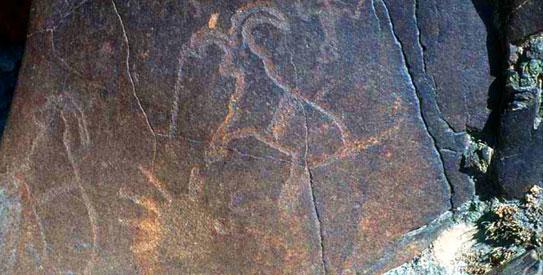Threatened rock carvings of Pakistan
Suhail Yusuf
Source -http://www.dawn.com/2011/05/18/basha-dam-threatens-thousands-of-ancient-rock-carvings.html

A collage of carvings and inscriptions of different periods shows the heritage on the brink of destruction as the proposed site of the Diamer-Basha Dam hosts some 30,000 ancient art carvings and inscriptions which may vanish forever. – 3D artwork by Mufassir A. Khan
Pakistan is going to lose one of the most precious rock art carvings due to construction of the Diamer-Basha Dam. The proposed site of the dam hosts some 30,000 ancient art carvings and inscriptions which may vanish forever due to the construction of this reservoir.
The northern area of Pakistan is a mountainous region which lies between the western Himalayas, the Korakoram in the east and the Hindukush in the west. Here, the junction of the ancient routes made the upper Indus a cradle and crossroads of different civilizations.
Travelers, invaders, merchants, pilgrims and artisans from different ages and cultures used the legendary silk route and its branches to enter in the region. Many of them left their cultural and religious signs on the rocks, boulders and cliffs.
The sun-tanned smooth rocks attracted more visitors and settlers to carve their own signs, symbols, inscriptions and artworks on the same locations. And hence, gradually a rock art archive accumulated in the area and eventually became a wonderland of some 50,000 rock carvings and 5,000 inscriptions from different civilizations ranging from the eighth millennium BC to the coming of Islam (since the 16th century AD) in the region.
The diversity of the rock carvings in the region turned the area into one of the most important rendezvous of petroglyphs in the world.
The history of discoveries
In 1884, a Hungarian traveler, Karl Eugen discovered a Buddhist carving in present Baltistan. In 1907, a veteran explorer, Ghulam Muhammad unveiled another Buddhist petroglyph from the Diamer district.
When the 750 km long, Karakorum Highway (the modern Silk Road) inaugurated in 1978, thousands of more engravings came to view which inspires a German scholar, Karl Jettmar to further explore the rock art wealth.
In 1980, Karl Jettmar and Pakistan’s father of archaeology, Ahmed Hassan Dani launched a Pak-German study group to systematically investigate the ancient rock art in the region.
Another research project entitled “Rock Carvings and Inscriptions along the Karakorum Highway” was initiated in 1983. The Heidelberg Academy of Humanities and Sciences and the Department of Archaeology of Gilgit were responsible for the study group. Professor Harald Hauptmann has been the head of the project since 1989 as a successor of Jettmar.
Talking Rocks
The Shatial, Thor, Hodur, Thalpan, Naupura, Chaghdo and other sites of northern Pakistan having clusters of carvings but the Basha-Diamer area holds thousands of very important rock carvings.
Hauptmann told Dawn.com that a total of 37,051 carvings on 5,928 boulders or rock faces will be inundated after the construction of the Diamer-Basha Dam.
The site represents hundreds of inscriptions in Brahmi, Sogdian, middle Persian, Chinese, Tibetan and even ancient Hebrew languages. Some 80 per cent of the writings are in Brahmi language.
These writings not only provide insights into the religious and political situation but also show the name of the rulers and a rough date of the time. These details of the inscriptions helped the experts arrange them chronologically.
One of the interesting Brahmi inscriptions can be read as; Martavyam Smartavyam, which means: “(Always) remember that (one day) you must die.”

Photo courtesy of Harald Hauptmann / Heidelberg Academy of Sciences and Humanities, Germany.
The earliest rock carvings in northern Pakistan dates back to the ninth millennium BC (roughly late Stone Age). Wild animals and hunting scenes are commonly found in this era but the hunter himself was never found.

This prehistoric Caprine depiction was discovered in Chilas . Photo courtesy of Harald Hauptmann / Heidelberg Academy of Sciences and Humanities, Germany.
The following Bronze Age petroglyphs represent the most spectacular carvings of giants. These life size male giant figures with stretched arms could be assumed to be images of ghosts, demons, deities or gods. Some 50 such carvings have been discovered in northern areas but all the giants have no facial features.

The mysterious “Giant Figures” represents the demons, deities or supernatural beings. More than 50 such carvings have been discovered in the area. – Photo courtesy of Harald Hauptmann / Heidelberg Academy of Sciences and Humanities, Germany.
In the third millennium BC, agriculture started in the region and carvings of horses were observed for first time. Then in the beginning of the first millennium BC, the area witnessed invasions by new ethnic groups such as the Sakan tribes. They carved sketches of Eurasian animals, most of them very interesting, bizarre and mythical in nature.
Later, another bunch of carvings appeared representing more mythical creatures, horses and warriors with Persian attire. These depicted the Iranian influence in the region and the expansion of Achaemenid Empire in sixth century BC.
Part. 2